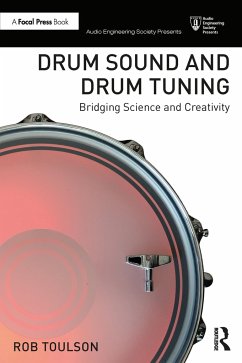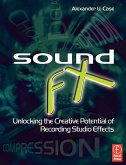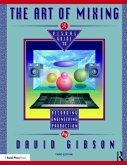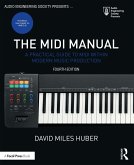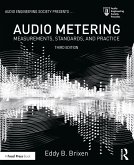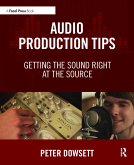- Broschiertes Buch
- Merkliste
- Auf die Merkliste
- Bewerten Bewerten
- Teilen
- Produkt teilen
- Produkterinnerung
- Produkterinnerung
Drum Sound and Drum Tuning assists drummers, sound engineers and music students in learning critical skills related to drum sound and achieving an optimised and personalised drum kit setup.
Andere Kunden interessierten sich auch für
![Sound FX Sound FX]() Alex CaseSound FX72,99 €
Alex CaseSound FX72,99 €![Introduction to Digital Music with Python Programming Introduction to Digital Music with Python Programming]() Michael S. HornIntroduction to Digital Music with Python Programming39,99 €
Michael S. HornIntroduction to Digital Music with Python Programming39,99 €![Dance Music Manual Dance Music Manual]() Rick SnomanDance Music Manual59,99 €
Rick SnomanDance Music Manual59,99 €![The Art of Mixing The Art of Mixing]() David GibsonThe Art of Mixing82,99 €
David GibsonThe Art of Mixing82,99 €![The MIDI Manual The MIDI Manual]() David Miles Huber (Freelance Recording EngineerThe MIDI Manual49,99 €
David Miles Huber (Freelance Recording EngineerThe MIDI Manual49,99 €![Audio Metering Audio Metering]() Eddy Brixen (audio consultant and lecturer based in DenmarkAudio Metering35,99 €
Eddy Brixen (audio consultant and lecturer based in DenmarkAudio Metering35,99 €![Audio Production Tips Audio Production Tips]() Peter DowsettAudio Production Tips43,99 €
Peter DowsettAudio Production Tips43,99 €-
-
-
Drum Sound and Drum Tuning assists drummers, sound engineers and music students in learning critical skills related to drum sound and achieving an optimised and personalised drum kit setup.
Hinweis: Dieser Artikel kann nur an eine deutsche Lieferadresse ausgeliefert werden.
Hinweis: Dieser Artikel kann nur an eine deutsche Lieferadresse ausgeliefert werden.
Produktdetails
- Produktdetails
- Audio Engineering Society Presents
- Verlag: Taylor & Francis Ltd
- Seitenzahl: 230
- Erscheinungstermin: 26. Mai 2021
- Englisch
- Abmessung: 234mm x 156mm x 13mm
- Gewicht: 404g
- ISBN-13: 9780367611187
- ISBN-10: 036761118X
- Artikelnr.: 60936119
- Herstellerkennzeichnung
- Libri GmbH
- Europaallee 1
- 36244 Bad Hersfeld
- gpsr@libri.de
- Audio Engineering Society Presents
- Verlag: Taylor & Francis Ltd
- Seitenzahl: 230
- Erscheinungstermin: 26. Mai 2021
- Englisch
- Abmessung: 234mm x 156mm x 13mm
- Gewicht: 404g
- ISBN-13: 9780367611187
- ISBN-10: 036761118X
- Artikelnr.: 60936119
- Herstellerkennzeichnung
- Libri GmbH
- Europaallee 1
- 36244 Bad Hersfeld
- gpsr@libri.de
Rob Toulson is an innovative musician, music producer, sound designer, and studio engineer working across most music and film genres. He has collaborated with many successful music artists and award-winning music producers, including Talvin Singh, Mediaeval Baebes, and Ethan Ash. He is an expert in musical acoustics and digital audio, with a doctorate in vibration and acoustics analysis and a full professor title in commercial music from University of Westminster, London, UK. He is also founder and director of RT60 Ltd, who develop cutting-edge technologies for the audio and music industries.
List of Figures
List of Tables
1 Introduction
1.1 Values of Great Drum Sound
1.2 Why Bother with Drum Tuning?
1.3 About this Book
1.3.1 Educational Approach
1.3.2 Online Resources
1.3.3 Interviews with Esteemed Professionals
1.3.4 Companion Software and Examples
1.4 Don't Forget to Listen!
2 Drumhead Vibration and the Science of Sound
2.1 Sound Sources, Acoustic Transmission and Sound Reception
2.2 Evaluating Frequencies
2.3 The Single Most Valuable Musical Acoustics Theory!
2.4 Measuring and Analysing Drum Modes
3 Tuning the Pitch of a Cylindrical Drum
3.1 Exploring the Pitch Range of a Cylindrical Drum
3.2 Musical Frequencies
3.3 Coupled Drumheads
4 Lug Tuning and Clearing the Drumhead
4.1 Evaluating the First Overtone of a Drum
4.2 Beat Frequencies
4.3 The Sound of a Uniformly Tuned Drumhead
4.4 Lug Tuning with Assistance
5 Tuning the Resonant Drumhead - What, Why and How?
5.1 Harmonics and In-Harmonic Overtones
5.2 Musical Intervals
5.3 Controlling Overtones and Intervals with the Resonant Drumhead
6 A Holistic Approach to Drum Tuning
6.1 Simplicity Wins
6.2 Setting the Fundamental Pitch
6.3 Implementing Lug Tuning and Resonant Head Tuning
6.4 Damping and Decay Times
7 The Wonderful World of Drumheads
7.1 Guitar Strings on Steroids!
7.2 The Drumhead Equation
7.3 Drumhead Types and Features
7.4 Resonant Drumhead Selection
7.5 Experience Drumheads!
8 Timbre: The Truth about Drum Shell Vibration
8.1 Introducing Timbre
8.2 Tuning Fork Example with Mass Loading
8.3 Drum Shell Vibration
8.4 Loading the Drum Shell
8.5 Bearing Edges and Precision Manufacturing
8.6 Considering the Drum Shell Vibration Frequency when Tuning
9 Tuning for Different Musical Styles and Genres
9.1 Creative Objectives
9.2 Drum Sizes for Different Music Genres
9.3 Pitches and Intervals on the Kit
9.4 Tuning Suggestions for Different Genres
9.5 Drumheads for Different Music Genres
10 Snare Drum Tuning
10.1 Key Aspects of Snare Tuning
10.2 Holistic Approach to Snare Tuning
10.3 Manipulating Snare Drum Timbre
10.4 Comparing Snare Timbre Example
11 Kick Drum Tuning
11.1 Kick Drum Tone and Dynamics
11.2 Drumheads for the Kick Drum
11.3 Kick Drum Tuning Range
11.4 Controlling the Kick Drum Timbre
12 Production and Preparation for Drum Recording
12.1 Production and Pre-Production
12.2 Setting Standards and Getting Results
12.3 Choosing and Evaluating the Recording Space
12.3.1 Room Size and Dimensions
12.3.2 Room Materials and Reverberation Characteristics
12.3.3 Sound Isolation and Background Noise Levels
12.3.4 Suitability for a Room's Use in a Recording Project
12.3.5 Positioning Drums within a Room
12.4 Tuning and Performance for Recording
13 Fundamental Technologies for Drum Recording
13.1 Microphones and Transducers
13.1.1 Dynamic Microphones
13.1.2 Condenser Microphones
13.1.3 Ribbon Microphones
13.1.4 Other Audio Transducers
13.2 Microphone Characteristics
13.2.1 Microphone Polar Patterns
13.2.2 Other Microphone Characteristics
13.3 The Complete Recording Signal Chain
13.3.1 Audio Convertors
13.3.2 Mixing Desk
13.3.3 Microphone Preamplifiers
13.3.4 Recording with FX
13.4 Monitoring and Foldback
13.4.1 Control Room Monitoring
13.4.2 Headphone Foldback
14 We Need to Talk About Phase!
14.1 What Exactly is Phase?
14.2 Time Delay and Comb Filtering
14.3 Mono Compatibility
14.4 Signal Polarity
15 Microphone Techniques for Recording Drums
15.1 Microphone Placement Approaches
15.2 Stereo Recording for Drums
15.2.1 Defining The Stereo Field
15.2.2 Spaced Pair Technique
15.2.3 X-Y Technique
15.2.4 Blumlein Pair Technique
15.2.5 ORTF Technique
15.2.6 Mid-Side Technique
15.2.7 Baffled Omnidirectional Pair Technique
15.2.8 Decca Tree Technique
15.2.9 Left-Right-Center Technique
15.3 Using Spot Microphone Techniques
15.3.1 Kick Drum Microphone Technique
15.3.2 Snare Drum Microphone Technique
15.3.3 Tom Drum Microphone Technique
15.3.4 Close Cymbal Microphone Technique
15.4 Room Microphones
15.5 Microphone Choices for Recording Drums
15.6 Developing a Personal Approach
16 Mixing Drums: Balance and Dynamics
16.1 Balance, Panning and Bussing
16.2 Dynamics Processing
16.2.1 Compression and Limiting
16.2.2 Gates and Expanders
16.2.3 Envelope Shaping
16.3 Hybrid mixing
17 Mixing Drums: Creative Processing
17.1 Equalisation and Spectral Processing
17.1.1 Cutting Low Frequencies
17.1.2 Treating the Fundamental and Overtones of Each Drum
17.1.3 Adding Attack and Presence
17.1.4 Controlling High Frequencies
17.2 Using Reverb to Regain Authenticity
17.3 Delay for Drums
17.4 Distortion and Enhancers
17.5 Sequential and Sidechain and Processing
17.6 Drum Replacement
17.7 The Final Mixdown
Index
List of Tables
1 Introduction
1.1 Values of Great Drum Sound
1.2 Why Bother with Drum Tuning?
1.3 About this Book
1.3.1 Educational Approach
1.3.2 Online Resources
1.3.3 Interviews with Esteemed Professionals
1.3.4 Companion Software and Examples
1.4 Don't Forget to Listen!
2 Drumhead Vibration and the Science of Sound
2.1 Sound Sources, Acoustic Transmission and Sound Reception
2.2 Evaluating Frequencies
2.3 The Single Most Valuable Musical Acoustics Theory!
2.4 Measuring and Analysing Drum Modes
3 Tuning the Pitch of a Cylindrical Drum
3.1 Exploring the Pitch Range of a Cylindrical Drum
3.2 Musical Frequencies
3.3 Coupled Drumheads
4 Lug Tuning and Clearing the Drumhead
4.1 Evaluating the First Overtone of a Drum
4.2 Beat Frequencies
4.3 The Sound of a Uniformly Tuned Drumhead
4.4 Lug Tuning with Assistance
5 Tuning the Resonant Drumhead - What, Why and How?
5.1 Harmonics and In-Harmonic Overtones
5.2 Musical Intervals
5.3 Controlling Overtones and Intervals with the Resonant Drumhead
6 A Holistic Approach to Drum Tuning
6.1 Simplicity Wins
6.2 Setting the Fundamental Pitch
6.3 Implementing Lug Tuning and Resonant Head Tuning
6.4 Damping and Decay Times
7 The Wonderful World of Drumheads
7.1 Guitar Strings on Steroids!
7.2 The Drumhead Equation
7.3 Drumhead Types and Features
7.4 Resonant Drumhead Selection
7.5 Experience Drumheads!
8 Timbre: The Truth about Drum Shell Vibration
8.1 Introducing Timbre
8.2 Tuning Fork Example with Mass Loading
8.3 Drum Shell Vibration
8.4 Loading the Drum Shell
8.5 Bearing Edges and Precision Manufacturing
8.6 Considering the Drum Shell Vibration Frequency when Tuning
9 Tuning for Different Musical Styles and Genres
9.1 Creative Objectives
9.2 Drum Sizes for Different Music Genres
9.3 Pitches and Intervals on the Kit
9.4 Tuning Suggestions for Different Genres
9.5 Drumheads for Different Music Genres
10 Snare Drum Tuning
10.1 Key Aspects of Snare Tuning
10.2 Holistic Approach to Snare Tuning
10.3 Manipulating Snare Drum Timbre
10.4 Comparing Snare Timbre Example
11 Kick Drum Tuning
11.1 Kick Drum Tone and Dynamics
11.2 Drumheads for the Kick Drum
11.3 Kick Drum Tuning Range
11.4 Controlling the Kick Drum Timbre
12 Production and Preparation for Drum Recording
12.1 Production and Pre-Production
12.2 Setting Standards and Getting Results
12.3 Choosing and Evaluating the Recording Space
12.3.1 Room Size and Dimensions
12.3.2 Room Materials and Reverberation Characteristics
12.3.3 Sound Isolation and Background Noise Levels
12.3.4 Suitability for a Room's Use in a Recording Project
12.3.5 Positioning Drums within a Room
12.4 Tuning and Performance for Recording
13 Fundamental Technologies for Drum Recording
13.1 Microphones and Transducers
13.1.1 Dynamic Microphones
13.1.2 Condenser Microphones
13.1.3 Ribbon Microphones
13.1.4 Other Audio Transducers
13.2 Microphone Characteristics
13.2.1 Microphone Polar Patterns
13.2.2 Other Microphone Characteristics
13.3 The Complete Recording Signal Chain
13.3.1 Audio Convertors
13.3.2 Mixing Desk
13.3.3 Microphone Preamplifiers
13.3.4 Recording with FX
13.4 Monitoring and Foldback
13.4.1 Control Room Monitoring
13.4.2 Headphone Foldback
14 We Need to Talk About Phase!
14.1 What Exactly is Phase?
14.2 Time Delay and Comb Filtering
14.3 Mono Compatibility
14.4 Signal Polarity
15 Microphone Techniques for Recording Drums
15.1 Microphone Placement Approaches
15.2 Stereo Recording for Drums
15.2.1 Defining The Stereo Field
15.2.2 Spaced Pair Technique
15.2.3 X-Y Technique
15.2.4 Blumlein Pair Technique
15.2.5 ORTF Technique
15.2.6 Mid-Side Technique
15.2.7 Baffled Omnidirectional Pair Technique
15.2.8 Decca Tree Technique
15.2.9 Left-Right-Center Technique
15.3 Using Spot Microphone Techniques
15.3.1 Kick Drum Microphone Technique
15.3.2 Snare Drum Microphone Technique
15.3.3 Tom Drum Microphone Technique
15.3.4 Close Cymbal Microphone Technique
15.4 Room Microphones
15.5 Microphone Choices for Recording Drums
15.6 Developing a Personal Approach
16 Mixing Drums: Balance and Dynamics
16.1 Balance, Panning and Bussing
16.2 Dynamics Processing
16.2.1 Compression and Limiting
16.2.2 Gates and Expanders
16.2.3 Envelope Shaping
16.3 Hybrid mixing
17 Mixing Drums: Creative Processing
17.1 Equalisation and Spectral Processing
17.1.1 Cutting Low Frequencies
17.1.2 Treating the Fundamental and Overtones of Each Drum
17.1.3 Adding Attack and Presence
17.1.4 Controlling High Frequencies
17.2 Using Reverb to Regain Authenticity
17.3 Delay for Drums
17.4 Distortion and Enhancers
17.5 Sequential and Sidechain and Processing
17.6 Drum Replacement
17.7 The Final Mixdown
Index
List of Figures
List of Tables
1 Introduction
1.1 Values of Great Drum Sound
1.2 Why Bother with Drum Tuning?
1.3 About this Book
1.3.1 Educational Approach
1.3.2 Online Resources
1.3.3 Interviews with Esteemed Professionals
1.3.4 Companion Software and Examples
1.4 Don't Forget to Listen!
2 Drumhead Vibration and the Science of Sound
2.1 Sound Sources, Acoustic Transmission and Sound Reception
2.2 Evaluating Frequencies
2.3 The Single Most Valuable Musical Acoustics Theory!
2.4 Measuring and Analysing Drum Modes
3 Tuning the Pitch of a Cylindrical Drum
3.1 Exploring the Pitch Range of a Cylindrical Drum
3.2 Musical Frequencies
3.3 Coupled Drumheads
4 Lug Tuning and Clearing the Drumhead
4.1 Evaluating the First Overtone of a Drum
4.2 Beat Frequencies
4.3 The Sound of a Uniformly Tuned Drumhead
4.4 Lug Tuning with Assistance
5 Tuning the Resonant Drumhead - What, Why and How?
5.1 Harmonics and In-Harmonic Overtones
5.2 Musical Intervals
5.3 Controlling Overtones and Intervals with the Resonant Drumhead
6 A Holistic Approach to Drum Tuning
6.1 Simplicity Wins
6.2 Setting the Fundamental Pitch
6.3 Implementing Lug Tuning and Resonant Head Tuning
6.4 Damping and Decay Times
7 The Wonderful World of Drumheads
7.1 Guitar Strings on Steroids!
7.2 The Drumhead Equation
7.3 Drumhead Types and Features
7.4 Resonant Drumhead Selection
7.5 Experience Drumheads!
8 Timbre: The Truth about Drum Shell Vibration
8.1 Introducing Timbre
8.2 Tuning Fork Example with Mass Loading
8.3 Drum Shell Vibration
8.4 Loading the Drum Shell
8.5 Bearing Edges and Precision Manufacturing
8.6 Considering the Drum Shell Vibration Frequency when Tuning
9 Tuning for Different Musical Styles and Genres
9.1 Creative Objectives
9.2 Drum Sizes for Different Music Genres
9.3 Pitches and Intervals on the Kit
9.4 Tuning Suggestions for Different Genres
9.5 Drumheads for Different Music Genres
10 Snare Drum Tuning
10.1 Key Aspects of Snare Tuning
10.2 Holistic Approach to Snare Tuning
10.3 Manipulating Snare Drum Timbre
10.4 Comparing Snare Timbre Example
11 Kick Drum Tuning
11.1 Kick Drum Tone and Dynamics
11.2 Drumheads for the Kick Drum
11.3 Kick Drum Tuning Range
11.4 Controlling the Kick Drum Timbre
12 Production and Preparation for Drum Recording
12.1 Production and Pre-Production
12.2 Setting Standards and Getting Results
12.3 Choosing and Evaluating the Recording Space
12.3.1 Room Size and Dimensions
12.3.2 Room Materials and Reverberation Characteristics
12.3.3 Sound Isolation and Background Noise Levels
12.3.4 Suitability for a Room's Use in a Recording Project
12.3.5 Positioning Drums within a Room
12.4 Tuning and Performance for Recording
13 Fundamental Technologies for Drum Recording
13.1 Microphones and Transducers
13.1.1 Dynamic Microphones
13.1.2 Condenser Microphones
13.1.3 Ribbon Microphones
13.1.4 Other Audio Transducers
13.2 Microphone Characteristics
13.2.1 Microphone Polar Patterns
13.2.2 Other Microphone Characteristics
13.3 The Complete Recording Signal Chain
13.3.1 Audio Convertors
13.3.2 Mixing Desk
13.3.3 Microphone Preamplifiers
13.3.4 Recording with FX
13.4 Monitoring and Foldback
13.4.1 Control Room Monitoring
13.4.2 Headphone Foldback
14 We Need to Talk About Phase!
14.1 What Exactly is Phase?
14.2 Time Delay and Comb Filtering
14.3 Mono Compatibility
14.4 Signal Polarity
15 Microphone Techniques for Recording Drums
15.1 Microphone Placement Approaches
15.2 Stereo Recording for Drums
15.2.1 Defining The Stereo Field
15.2.2 Spaced Pair Technique
15.2.3 X-Y Technique
15.2.4 Blumlein Pair Technique
15.2.5 ORTF Technique
15.2.6 Mid-Side Technique
15.2.7 Baffled Omnidirectional Pair Technique
15.2.8 Decca Tree Technique
15.2.9 Left-Right-Center Technique
15.3 Using Spot Microphone Techniques
15.3.1 Kick Drum Microphone Technique
15.3.2 Snare Drum Microphone Technique
15.3.3 Tom Drum Microphone Technique
15.3.4 Close Cymbal Microphone Technique
15.4 Room Microphones
15.5 Microphone Choices for Recording Drums
15.6 Developing a Personal Approach
16 Mixing Drums: Balance and Dynamics
16.1 Balance, Panning and Bussing
16.2 Dynamics Processing
16.2.1 Compression and Limiting
16.2.2 Gates and Expanders
16.2.3 Envelope Shaping
16.3 Hybrid mixing
17 Mixing Drums: Creative Processing
17.1 Equalisation and Spectral Processing
17.1.1 Cutting Low Frequencies
17.1.2 Treating the Fundamental and Overtones of Each Drum
17.1.3 Adding Attack and Presence
17.1.4 Controlling High Frequencies
17.2 Using Reverb to Regain Authenticity
17.3 Delay for Drums
17.4 Distortion and Enhancers
17.5 Sequential and Sidechain and Processing
17.6 Drum Replacement
17.7 The Final Mixdown
Index
List of Tables
1 Introduction
1.1 Values of Great Drum Sound
1.2 Why Bother with Drum Tuning?
1.3 About this Book
1.3.1 Educational Approach
1.3.2 Online Resources
1.3.3 Interviews with Esteemed Professionals
1.3.4 Companion Software and Examples
1.4 Don't Forget to Listen!
2 Drumhead Vibration and the Science of Sound
2.1 Sound Sources, Acoustic Transmission and Sound Reception
2.2 Evaluating Frequencies
2.3 The Single Most Valuable Musical Acoustics Theory!
2.4 Measuring and Analysing Drum Modes
3 Tuning the Pitch of a Cylindrical Drum
3.1 Exploring the Pitch Range of a Cylindrical Drum
3.2 Musical Frequencies
3.3 Coupled Drumheads
4 Lug Tuning and Clearing the Drumhead
4.1 Evaluating the First Overtone of a Drum
4.2 Beat Frequencies
4.3 The Sound of a Uniformly Tuned Drumhead
4.4 Lug Tuning with Assistance
5 Tuning the Resonant Drumhead - What, Why and How?
5.1 Harmonics and In-Harmonic Overtones
5.2 Musical Intervals
5.3 Controlling Overtones and Intervals with the Resonant Drumhead
6 A Holistic Approach to Drum Tuning
6.1 Simplicity Wins
6.2 Setting the Fundamental Pitch
6.3 Implementing Lug Tuning and Resonant Head Tuning
6.4 Damping and Decay Times
7 The Wonderful World of Drumheads
7.1 Guitar Strings on Steroids!
7.2 The Drumhead Equation
7.3 Drumhead Types and Features
7.4 Resonant Drumhead Selection
7.5 Experience Drumheads!
8 Timbre: The Truth about Drum Shell Vibration
8.1 Introducing Timbre
8.2 Tuning Fork Example with Mass Loading
8.3 Drum Shell Vibration
8.4 Loading the Drum Shell
8.5 Bearing Edges and Precision Manufacturing
8.6 Considering the Drum Shell Vibration Frequency when Tuning
9 Tuning for Different Musical Styles and Genres
9.1 Creative Objectives
9.2 Drum Sizes for Different Music Genres
9.3 Pitches and Intervals on the Kit
9.4 Tuning Suggestions for Different Genres
9.5 Drumheads for Different Music Genres
10 Snare Drum Tuning
10.1 Key Aspects of Snare Tuning
10.2 Holistic Approach to Snare Tuning
10.3 Manipulating Snare Drum Timbre
10.4 Comparing Snare Timbre Example
11 Kick Drum Tuning
11.1 Kick Drum Tone and Dynamics
11.2 Drumheads for the Kick Drum
11.3 Kick Drum Tuning Range
11.4 Controlling the Kick Drum Timbre
12 Production and Preparation for Drum Recording
12.1 Production and Pre-Production
12.2 Setting Standards and Getting Results
12.3 Choosing and Evaluating the Recording Space
12.3.1 Room Size and Dimensions
12.3.2 Room Materials and Reverberation Characteristics
12.3.3 Sound Isolation and Background Noise Levels
12.3.4 Suitability for a Room's Use in a Recording Project
12.3.5 Positioning Drums within a Room
12.4 Tuning and Performance for Recording
13 Fundamental Technologies for Drum Recording
13.1 Microphones and Transducers
13.1.1 Dynamic Microphones
13.1.2 Condenser Microphones
13.1.3 Ribbon Microphones
13.1.4 Other Audio Transducers
13.2 Microphone Characteristics
13.2.1 Microphone Polar Patterns
13.2.2 Other Microphone Characteristics
13.3 The Complete Recording Signal Chain
13.3.1 Audio Convertors
13.3.2 Mixing Desk
13.3.3 Microphone Preamplifiers
13.3.4 Recording with FX
13.4 Monitoring and Foldback
13.4.1 Control Room Monitoring
13.4.2 Headphone Foldback
14 We Need to Talk About Phase!
14.1 What Exactly is Phase?
14.2 Time Delay and Comb Filtering
14.3 Mono Compatibility
14.4 Signal Polarity
15 Microphone Techniques for Recording Drums
15.1 Microphone Placement Approaches
15.2 Stereo Recording for Drums
15.2.1 Defining The Stereo Field
15.2.2 Spaced Pair Technique
15.2.3 X-Y Technique
15.2.4 Blumlein Pair Technique
15.2.5 ORTF Technique
15.2.6 Mid-Side Technique
15.2.7 Baffled Omnidirectional Pair Technique
15.2.8 Decca Tree Technique
15.2.9 Left-Right-Center Technique
15.3 Using Spot Microphone Techniques
15.3.1 Kick Drum Microphone Technique
15.3.2 Snare Drum Microphone Technique
15.3.3 Tom Drum Microphone Technique
15.3.4 Close Cymbal Microphone Technique
15.4 Room Microphones
15.5 Microphone Choices for Recording Drums
15.6 Developing a Personal Approach
16 Mixing Drums: Balance and Dynamics
16.1 Balance, Panning and Bussing
16.2 Dynamics Processing
16.2.1 Compression and Limiting
16.2.2 Gates and Expanders
16.2.3 Envelope Shaping
16.3 Hybrid mixing
17 Mixing Drums: Creative Processing
17.1 Equalisation and Spectral Processing
17.1.1 Cutting Low Frequencies
17.1.2 Treating the Fundamental and Overtones of Each Drum
17.1.3 Adding Attack and Presence
17.1.4 Controlling High Frequencies
17.2 Using Reverb to Regain Authenticity
17.3 Delay for Drums
17.4 Distortion and Enhancers
17.5 Sequential and Sidechain and Processing
17.6 Drum Replacement
17.7 The Final Mixdown
Index

